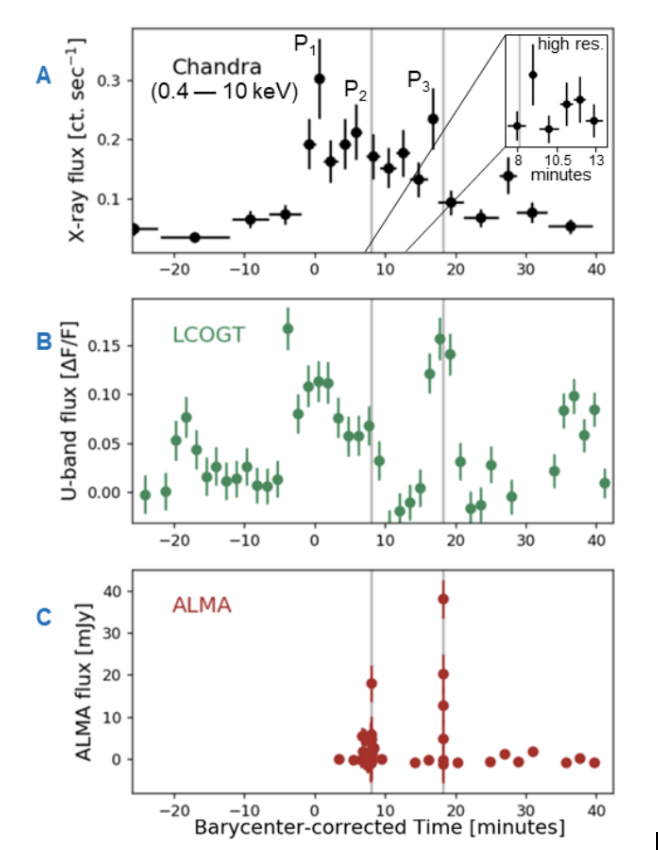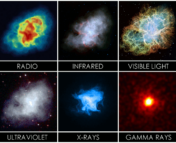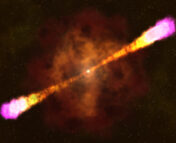Authors: Ward, H., MacGregor, M., Osten R. et al.
First Author’s Institution: University of Colorado, USA
Status: arxiv [open access]
Most stars like to flare. Stellar flares, i.e. rapid, short-duration increases in brightness are particularly common in M-dwarf stars – a class of stars that is very likely to host Earth-like planets around them. Studying the variety of stellar flares of M-dwarfs is important to understand their effects on the planets, especially on the atmospheres of planets around these stars. Today’s paper describes detailed observations of a flare in the very nearby M-type star – Proxima Cen.
What are M-dwarf flares
M-dwarf stars have strong magnetic fields and convective envelopes. The magnetic field lines are dragged around due to convective motion in the envelope. This magnetic activity can cause a sudden energy release through a mechanism known as magnetic reconnection. This burst of energy causes the star to flare and emit a pulse of radiation across the electromagnetic spectrum. Several flares in M-dwarf stars have been studied to date, however only the most energetic flares have been studied at multiple wavelengths. The lower energy flares (or squeaks, as the authors call them) have received comparatively lesser attention. Understanding these low-energy flares is crucial because they are expected to be far more common than their more energetic counterparts, and are thus expected to have significant effects on the planets that orbit the star.
The Flare in Proxima Cen
The authors conducted a campaign to monitor an M-dwarf star at multiple wavelengths across the electromagnetic spectrum to search for low-energy flares. For the subject of this study, they chose the star Proxima Centauri – the closest M-dwarf star to the Earth. They monitored this star with X-ray, optical and radio telescopes, and on May 6 2019, they detected a flare!
On this day, the authors observed the star with the Atacama Large Millimeter Array (ALMA) and the Chandra telescopes. ALMA is a radio telescope operating at millimeter wavelengths, while Chandra is a space telescope that operates at X-ray wavelengths. Both telescopes detected a flare from Proxima Cen. In X-rays, Chandra witnessed a 40 minute-long burst in the “soft-Xray band”. The soft-Xray band has energies of ~1-10 keV (for comparison, the energy in a visible photon is ~ 1eV). The X-ray flare shows a complex structure with a rapid rise followed by a slow second peak, and a final third peak on the decline. The ALMA telescope also detected the flare at a wavelength of 1.3mm (for comparison, the wavelength of visible light is ~500nm ~ 10-4 mm!). Unlike the X-ray flare, the millimeter flare lasted only for a few seconds, and showed only two peaks – coincident with the final two peaks seen in X-rays. It turns out that during the first X-ray peak, ALMA suffered a calibration glitch, which is why it did not detect the first peak.
In addition to X-rays and millimeter, the flare was also detected at optical wavelengths (i.e. visual light) by the LCOGT telescopes. These telescopes clearly detected the flare in the U-band (~300 nm wavelength), for a duration of ~30 mins.
The profile of the flare at different wavelengths is shown in Figure 1. The shorter duration of the flare in the millimeter bands compared to the optical and X-ray bands isn’t very surprising. The millimeter emission traces the sudden initial acceleration of charged particles, which heats up the outer layers of the stars. These hot layers then subsequently emit at X-ray and optical wavelengths over a longer time duration.

What did we learn from this flare?
From their multiwavelength observations, the authors calculate that the total energy released in this flare was about 1026 ergs. While this is a tremendous amount of energy (the energy released by an atomic bomb explosion is ~1021 ergs), it is still small compared to M-dwarf flares that have been studied in the past, which have energies of ~1034 ergs. Such low energy flares have been extensively studied for the Sun, which underwent 175 such flares during its last 11-year solar cycle. The observations of this flare thus provide a unique opportunity to compare solar-flares to M-dwarf flares.
The authors find that the ratios of both the millimeter to X-ray flux and the optical to X-ray flux are much larger for the Proxima-Cen flare than solar flares. This aside, several properties such as the temperature and relative timings of the flare in different wavelengths are similar to those of solar flares. This suggests that the flare emission properties are similar across a broad range of flare energies. If the flare-emission properties are same for M-dwarf and solar flares, this observation could suggest that millimeter-emission should be present in all M-dwarf flares as well. This is important, because millimeter emission helped the authors understand the nature of the plasma in the M-dwarf envelope.
Motivated by these observations, the authors are continuing their multiwavelength campaign to search for additional flares from other M-dwarf stars with a variety of ages and activity levels. These multi-wavelength observations will help understand similarities of these flares with their solar counterparts, the nature of the plasma in their envelopes, and their effects on the orbiting planets.
Edited by : Benjamin Cassese
Featured Image Credit : NASA’s Goddard Space Flight Center/S. Wiessinger




